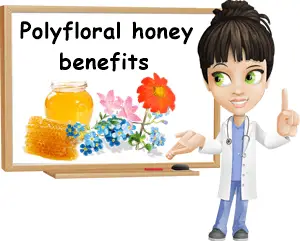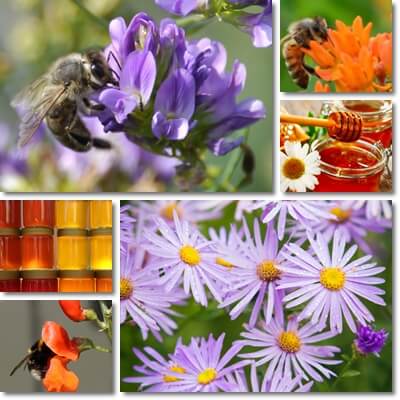Polyfloral honey is a type of honey made from the flower nectar and pollen of several plant species flowering roughly at the same time of year. It is a fairly common type of honey, yet unique, with a varying taste and color. Some people find it is a much better-tasting option than monofloral varieties because it contains nectar and pollen from multiple species of flowering plants, reuniting their flavor characteristics into an authentic aromatic profile. More important, polyfloral honey is considered to be superior to monofloral types primarily because it brings together varied properties and medicinal effects for what is thought to be a more potent therapeutic action.
What is polyfloral honey and how is it made? Polyfloral honey is obtained roughly the same way as monofloral varieties, meaning honey bees source flower nectar and pollen and process it using digestive enzymes to produce honey. And to make unique and good-tasting polyfloral honeys, bees have access to different kinds of flowers in bloom at the same time. For example, in early and mid-spring in a temperate region, they may collect nectar from apple blossoms, cherry blossoms, quince flowers, pear tree flowers, but also dandelions, some buttercup species or other wildflowers present in the orchard, pasture, garden or field where the bees are located. Beekeepers generally move their honey bees with the intent of producing a certain type of honey with a particular flavor profile and appearance.

Considering the appreciation polyfloral varieties enjoy, a beekeeper will attempt to reproduce the honey that has had the most success with its customers. However, while it is possible to obtain a similar honey every year, studies show no two polyfloral honeys are exactly the same because inevitably they will contain varying amounts of different flower nectars. Climate and weather conditions are just two of the factors that decide what flowers will be more prolific in a given year and thus enjoy a higher representation within a honey.
There will be years when some flowers, cultivated or wild, will benefit more from weather conditions and be more abundant and thus more appealing for honey bees, which will surely incorporate more of their nectar and pollen into their honey. Because it is not possible to prevent a honey bee from sourcing the nectar of certain flowers but not that of others if they are in bloom in the same region and at the same time of year. There may be quite significant differences in polyfloral honeys that are supposed to have roughly the same nectar composition, whether they come from different countries, regions, beekeepers, honey bee colonies or the same ones, although general characteristic are laboriously preserved.
Mono vs polyfloral honey
What is the difference between polyfloral and monofloral honey? Polyfloral honey is a type made from the flower nectar and pollen of multiple flowering plants. Monofloral honey is a type made for the most part from the flower nectar and pollen of one plant species. But although it has one predominant nectar source, monofloral honey contains smaller amounts of several others as well. Depending on the country or region, different standards for different types of honey may be in place. For example, in order to be considered monofloral, acacia honey is required to have a minimum of 30% of its total content of pollen from acacia flowers, clover honey can easily have 50% or more clover pollen, while the best manuka honey can have up to 90% manuka pollen.

Why pollen? Because that’s how floral sources are determined and honey purity is evaluated. When several honeys are harvested separately and mixed together by producers to obtain a certain taste or appearance, then the resulting honey is called a ‘blend of honeys’ or ‘blended honey‘.
What does polyfloral honey look, taste and smell like? Different varieties will have their own, unique appearance and aroma. But because only certain nectars give honey a very light pigment and polyfloral honeys contain different nectars, they are often a medium amber color or have darker, brown-reddish reflections, but this is not a rule. As for the taste, they tend to have a stronger flavor profile and sometimes bolder notes, hence the reason some prefer them to milder-tasting monofloral varieties.
Health effects
What are the health benefits of polyfloral honey? Honey in general shares similar properties, but each nectar in its composition brings with it elements with a unique therapeutic action, characteristic of the plant of origin, making polyfloral honey a delicious and, sometimes, healthier option than monofloral varieties. Here are 7 wonderful properties, benefits and uses of polyfloral honeys:
1) Tonic and nourishing. Polyfloral honey is considered to have a more varied nutritional profile than certain monofloral honeys simply because of the variety of nectar types in its composition which is more likely to provide a wider range of nutrients and other biologically active elements. Polyfloral honeys are a source of multiple essential nutrients like B vitamins and vitamin C, potassium, calcium, iron, phosphorus, but also other elements with nutritional value like pollen particles, enzymes, amino acids etc. The raw, unprocessed and unheated honey is good for low blood sugar levels, low energy levels and fatigue.
2) Strong immune-boosting properties. Rich in different pollen types, polyfloral honey exhibits immuno-modulating activity, more exactly it stimulates the immune system to respond better to infection and disease. Pollen does this by increasing vitamin C content in the immune system organs that produce white blood cells, by reducing inflammation and exerting antioxidant and antibiotic properties. However, other antioxidants and the antibacterial elements in polyfloral honeys also contribute to a stronger immune system and better health.
But plant pollen is also a source of allergic reactions. If you have multiple pollen allergies, avoid polyfloral honeys because you never really know what types of pollen they contain. If you are allergic to honey bees, then it is recommended to avoid anything they produce (honey, propolis, royal jelly, bee bread).
3) Wound healing and other skin benefits. The antibacterial elements in polyfloral honey (the antiseptic hydrogen peroxide) and characteristics (acidic pH, low moisture content, natural sugars) give it wound healing benefits. Using it as a natural face mask can help reduce acne, nourish the skin and give it a natural glow.
4) Good for colds, flu and other respiratory infections. Honey in general has natural antibacterial, antiseptic and even antibiotic properties, helping inhibit bacteria growth and reduce bacteria numbers. Combined with its tonic, strengthening effect and immune-boosting properties, it can prove a great ally for the treatment of respiratory tract infections like the common cold, flu, sinusitis, bronchitis etc.
5) Natural remedy for cough and sore throat. Eating the raw honey helps form a protective barrier over the throat lining, preventing further inflammation and reducing existing irritation. This helps soothe throat soreness and calms cough. However, to produce its benefits, the honey has to be raw, unprocessed and unheated. This means that if we added to tea, we should first let the tea cool down to room temperature because heat destroys the beneficial properties of honey in general.
6) Good for gastritis and stomach upset. Eating raw honey, polyfloral included, is said to help calm stomach upset and relieve irritation of the stomach lining, potentially helping improve gastritis. The natural sugars in polyfloral honeys boast mild prebiotic properties, helping improve transit time and regulating digestion. Some say eating honey is also good for constipation and indeed, some people report experiencing diarrhea if they eat too much, proof it stimulates transit.
7) Richer in antioxidants. Generally, the darker the color, the more pigments the honey contains and many natural pigments also exert antioxidant effects. Polyfloral varieties have been found to have a stronger antioxidant action than light-colored monofloral honeys, but not necessarily the strongest (see the benefits of manuka honey).
Comparison
Which is better: polyfloral or monofloral honey? There are benefits to both monofloral and polyfloral honey types and honey, irrespective of its nectar and pollen profile, remains a healthy food with a varied therapeutic action. This being said, there are arguments in favor of both types being better than the other. The truth lies with the consumer and his or her use of the honey. For example, someone may be allergic to linden, dandelion and chestnut pollen, but not acacia. So for that person, pure acacia honey will be unquestionably the best option.
